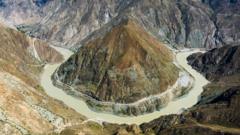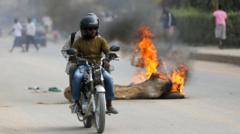Following protests against the planned Gangtuo dam, which threatens Tibetan cultural sites, hundreds of protestors faced severe actions including arrests and beatings. The incident highlights the fragile situation regarding Tibetan autonomy under Chinese governance, prompting international concern.
Tibetan Protests Erupt Over Controversial Dam Project Amid Harsh Crackdown

Tibetan Protests Erupt Over Controversial Dam Project Amid Harsh Crackdown
A crackdown harsher than usual follows rare protests in Tibet against China's plans for a controversial dam, causing injuries and arrests among local residents.
A controversial dam project planned by the Chinese government on the Jinsha River has ignited rare and fierce protests among Tibetan residents. The protests, which took place earlier this year, prompted a heavy crackdown by authorities, resulting in numerous arrests and reported physical abuse of demonstrators, as revealed by the BBC.
The Gangtuo dam, located in regions predominantly inhabited by Tibetans in Sichuan province, poses significant risks to culturally important areas. Residents have expressed deep concerns over the flooding of historical sites and displacement due to construction plans that threaten their way of life. One such site, the 700-year-old Wangdui Monastery, contains sacred artifacts and holds spiritual significance for local Buddhists.
Reports indicate that the unrest began in February when government officials reportedly warned residents about imminent evictions linked to the dam. This news spurred protests of hundreds gathering outside government buildings in Dege. Monks were seen pleading for mercy in an attempt to halt the project, captured in videos verified by the BBC.
Chinese authorities swiftly retaliated, arresting and detaining hundreds of participants in the protests and conducting raids on homes. Eyewitness accounts reveal instances of excessive force utilized against detainees, with some sustaining serious injuries during interrogations.
From the onset, Chinese officials have maintained that the construction of the Gangtuo dam would not progress without community consent. However, a recent UN report suggests local residents were inadequately informed about the project, with critical discussions and documents not provided in the Tibetan language, raising concerns about true consent from the affected communities.
In light of the protests and ramped-up security measures, communication has diminished drastically. Those who previously shared stories and details of their living conditions are now frightened to speak out, fearing renewed crackdowns on dissent.
Despite the Chinese government's claims that the dam will foster development and improve living standards, rights groups argue this development often leads to exploitation and the loss of cultural heritage for Tibetan communities. With preceding examples of dislocation and dissatisfaction stemming from similar projects, concerns mount regarding the future of Tibetan culture and the rights of its people in the face of rapid industrialization.



















